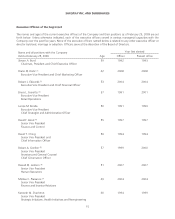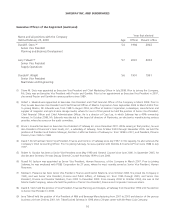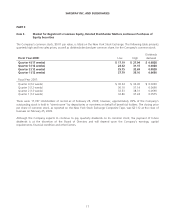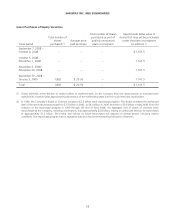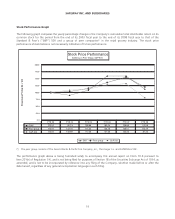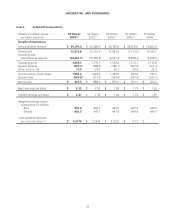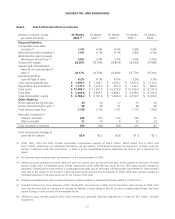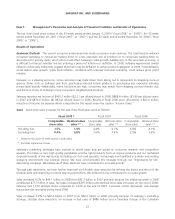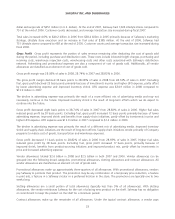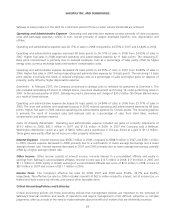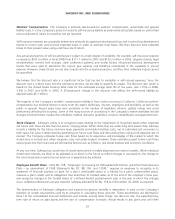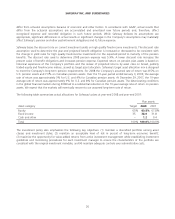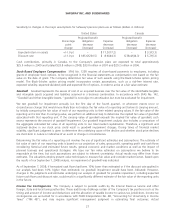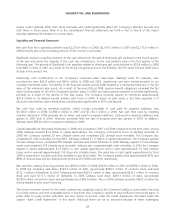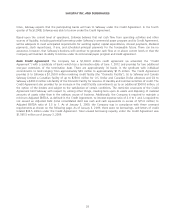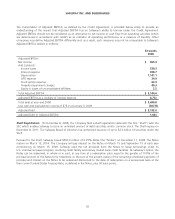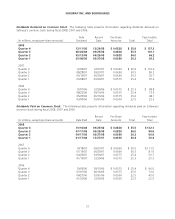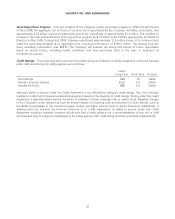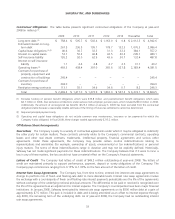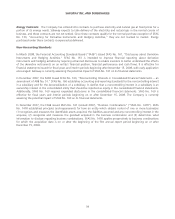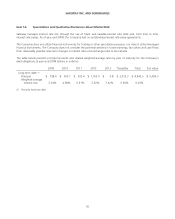Safeway 2008 Annual Report Download - page 45
Download and view the complete annual report
Please find page 45 of the 2008 Safeway annual report below. You can navigate through the pages in the report by either clicking on the pages listed below, or by using the keyword search tool below to find specific information within the annual report.SAFEWAY INC. AND SUBSIDIARIES
Workers’ Compensation The Company is primarily self-insured for workers’ compensation, automobile and general
liability costs. It is the Company’s policy to record its self-insurance liability as determined actuarially, based on claims filed
and an estimate of claims incurred but not yet reported.
Self-insurance reserves are actuarially determined primarily by applying historical paid loss and incurred loss development
trends to current cash and incurred expected losses in order to estimate total losses. We then discount total expected
losses to their present value using a risk free rate of return.
Any actuarial projection of self-insured losses is subject to a high degree of variability. For example, self-insurance expense
increased to $161.6 million in fiscal 2008 from $117.1 million in 2007 and $133.2 million in 2006. Litigation trends, legal
interpretations, benefit level changes, claim settlement patterns and similar factors influenced historical development
trends that were used to determine the current year expense and therefore contributed to the variability in annual
expense. However, these factors are not direct inputs into the actuarial projection, and thus their individual impact cannot
be quantified.
We believe that the discount rate is a significant factor that has led to variability in self-insured expenses. Since the
discount rate is a direct input into the estimation process, we are able to quantify its impact. The discount rate, which is
based on the United States Treasury Note rates for the estimated average claim life of five years, was 1.75% in 2008,
3.5% in 2007 and 4.5% in 2006. A 25-basis-point change in the discount rate affects the self-insured liability by
approximately $5.3 million.
The majority of the Company’s workers’ compensation liability is from claims occurring in California. California workers’
compensation has received intense scrutiny from the state’s politicians, insurers, employers and providers, as well as the
public in general. Recent years have seen escalation in the number of legislative reforms, judicial rulings and social
phenomena affecting this business. Some of the many sources of uncertainty in the Company’s reserve estimates include
changes in benefit levels, medical fee schedules, medical utilization guidelines, vocation rehabilitation and apportionment.
Store Closures Safeway’s policy is to recognize losses relating to the impairment of long-lived assets when expected
net future cash flows are less than the assets’ carrying values. When stores that are under long-term leases close, Safeway
records a liability for the future minimum lease payments and related ancillary costs, net of estimated cost recoveries. In
both cases, fair value is determined by estimating net future cash flows and discounting them using a risk-adjusted rate of
interest. The Company estimates future cash flows based on its experience and knowledge of the market in which the
closed store is located and, when necessary, uses real estate brokers. However, these estimates project future cash flows
several years into the future and are affected by factors such as inflation, real estate markets and economic conditions.
At any one time, Safeway has a portfolio of closed stores which is widely dispersed over several markets. While individual
closed store reserves are likely to be adjusted up or down in the future to reflect changes in assumptions, the change to
the total closed store reserve has not been nor is expected to be material.
Employee Benefit Plans SFAS No. 158, “Employers’ Accounting for Defined Benefit Pension and Other Postretirement
Plans – an amendment of FASB Statements No. 87, 88, 106, and 132(R),” requires an employer to recognize in its
statement of financial position an asset for a plan’s overfunded status or a liability for a plan’s underfunded status,
measure a plan’s assets and its obligations that determine its funded status as of the end of the employer’s fiscal year,
and recognize changes in the funded status of a defined benefit postretirement plan in the year in which the changes
occur. Additional disclosures are also required. Safeway adopted SFAS No. 158 as of December 30, 2006, as required.
The determination of Safeway’s obligation and expense for pension benefits is dependent, in part, on the Company’s
selection of certain assumptions used by its actuaries in calculating these amounts. These assumptions are disclosed in
Note I to the consolidated financial statements and include, among other things, the discount rate, the expected long-
term rate of return on plan assets and the rate of compensation increases. Actual results in any given year will often
25


